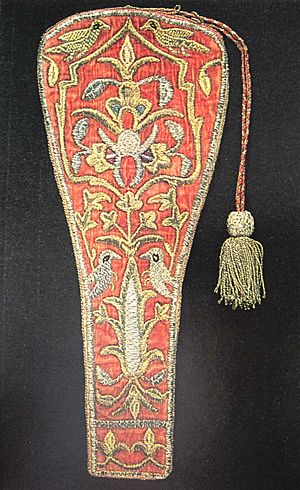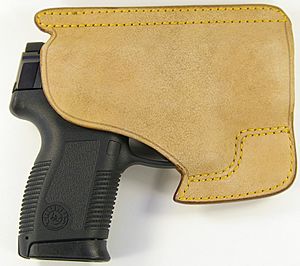Handgun holster facts for kids
A handgun holster is a special holder for a handgun. It keeps the gun safe and secure, but also makes it easy to grab quickly when needed. Holsters are often worn on a belt or waistband. But they can also be attached to other parts of the body, like the ankle. Some holsters have straps or flaps. These help keep the gun from falling out or protect it from bad weather.
Contents
What Holsters Do
Holsters are made to protect a handgun. They also keep it securely in place. At the same time, they allow you to get the gun easily. Sometimes, being able to grab the gun quickly is very important. This is especially true for a gun used for safety. Users need to choose a holster that balances safety and quick access.
One key job of a holster is to cover the trigger. Many people carry a gun with a bullet ready to fire. This makes the gun ready to use right away. Modern handguns have safety features. These stop the gun from firing unless the trigger is pulled. A good holster covers the trigger. This helps prevent the gun from going off by accident. Holsters made for a specific gun model work best. Stiff materials also help keep the trigger safe when the gun is in the holster.
Most holsters are designed for one-handed use. This means you can take the gun out and put it back with the same hand. To do this, the holster must be stiff. It needs to hold its shape even when the gun is not inside.
Holsters usually attach to a person's belt or pants. Some, like ankle holsters, have their own support. Other holsters fit inside a pocket. They add stability and protection. This keeps the gun more secure than if it were just loose in the pocket.
Holsters are usually worn where they are easy to reach. Common places include:
- On the waist (outside or inside the pants).
- Behind the back.
- On the ankle.
- On the chest (in a special band or shoulder holster).
- On the upper thigh.
Sometimes, holsters are hidden inside a bag, like a purse.
Holster Materials
Holsters are usually made from strong, stiff materials. The most traditional material is leather. Leather looks nice and can be dyed many colors. It can also have designs pressed into it.
Ballistic nylon is another common fabric. It is stiff and resists wear. It is also thick enough to protect the gun.
Molded plastics, like Kydex, are also popular. They are cheap and very tough.
Types and Styles of Holsters
Holsters come in many shapes and sizes. They use different ways to hold and release the gun. Some are simple leather pouches. Others are very protective with flaps. There are also special holsters for shooting competitions. The many types show how holsters are used in different situations. They also show what users prefer.
Holster Categories by Use
Holsters can be grouped into four main types based on how they are used:
- Duty holsters: Worn by police officers and security guards in uniform.
- Tactical holsters: Used by military and law enforcement in certain situations.
- Concealment holsters: Worn by plainclothes officers and regular people. These are designed to be hidden.
- Sporting holsters: Used for shooting sports and hunting.
Duty holsters are worn openly. So, hiding them is not important. Keeping the gun secure and looking good are key. They can be made of leather, nylon, or plastic. They attach to a duty belt on the dominant side. These holsters are usually for larger handguns.
A main feature of duty holsters is how well they hold the gun. Modern police holsters have different levels of security. Some features are passive. This means they work without the officer doing anything extra. Other features are active. These need the officer to do something specific to draw the gun. More security makes it harder for someone to grab the gun. But it might also make it slower for the officer to draw it. Officers choose a balance between speed and security.
Tactical and military holsters are often made of nylon or plastic. They might have a camouflage pattern to match uniforms. They often hang lower on the leg. They also have a way to keep the gun secure. Some military holsters still use an old flap design. This design protects the gun from weather. But it can be slow to draw from.
Weapon security is usually more important for police. This is because their work environments are different from military ones.
Concealment holsters are made to be easily hidden. They are also light and not bulky. They are usually for smaller handguns. These are easier to hide. Concealment holsters are worn under clothes. This could be on the belt under a coat, or in an ankle holster. Since they are close to the body, comfort is important. They often have wide surfaces to spread pressure. This prevents rubbing the skin. Protecting the gun from sweat is also important. The outside of the holster is often wider. This helps hide the gun's shape. It prevents "printing," where the gun's outline shows through clothes.
Sporting holsters come in many styles. Some allow for very fast drawing. Others are highly adjustable for competitive shooting. There are also old-fashioned holsters for Cowboy Action Shooting. Holsters for hunting offer high security and protection. Simple holsters are used for casual target practice. Like other sports gear, sporting holsters change to fit the rules of the game.
Hunting holsters can be special. They might carry large handguns or guns with telescopic sights. Large handguns are often carried across the shoulder. Slow access is okay here. This is because the gun is not usually for defense.
Holster Types by How They Are Worn
Here are some common ways holsters are worn:
- Outside the waistband (OWB) or belt holsters: These are common for police and people who open carry a gun. They can be worn high and close to the body. They can be hidden under a long shirt or jacket.
- Inside the waistband (IWB) holsters: These clip to a belt. They hold the gun inside your pants. Some let you tuck a shirt over the gun and holster. A type called "appendix inside the waistband" (AIWB) is worn in the front of the pants.
- Appendix rigs: These are AIWB holsters with an attached holder for extra bullets.
- Below waistband (BWB): This style attaches below the waistline. It hides the gun deeper than a regular IWB holster.
- Shoulder holsters: These have straps like a backpack. The holster is on one side. They hold the gun pointing down, up, or behind you. They are comfortable because they spread the gun's weight across your shoulders. They are good for wearing under a jacket.
- Sling holsters: These are like shoulder holsters. But they have one strap over the shoulder and one around the chest. They were used by pilots and drivers in World War II. They were easier to use while sitting.
- Belly band holsters: This is a wide elastic belt with a holster built in. It's worn under a shirt. It needs to be very tight to stay in place. This can be uncomfortable.
- Pocket holsters: Used for very small guns, like pocket pistols.
- Small of back holsters: These place the gun in the middle of your back. They can hide even large guns well. However, falling on a gun in this position can cause serious spinal injury. Because of this, some police departments do not allow them.
- Groin holsters: These place the gun mostly below the waistline in front. They allow for easy movement and clothing choices.
- Thigh holsters (or drop leg holsters): These are popular for police. They hold the gun on the leg where the hand naturally hangs. This allows for a fast draw. Early U.S. cavalry used them. Modern ones often use special straps.
- Ankle (or boot) holsters: These hide the gun very well. Police officers use them for a backup gun. But some officers find that even small guns bounce too much during physical activity.
- Chest holsters: These can attach to special vests. They are often easier to draw from than belt holsters when sitting in a vehicle.
- Strut holsters: Used only for hidden carry. They are worn above the belt, under the arm or toward the front. A special "strut" connects to your belt. This holds the gun in place. A flexible band keeps the gun close to your body.
- Pancake holsters: These are usually made of two pieces of material. The gun fits between them. They have belt slots. They are worn slightly off the hip. This style pulls the gun tight against the body for better hiding.
- Cross-draw belt holsters: Worn on the opposite side of your dominant hand. Drawing from a seated position can be more comfortable and quicker. They can be good for a backup gun. They are also a good choice for women due to comfort.
Other special holsters fit inside briefcases, purses, or even clothing like a tank top or bra.
How Holsters Attach
The safest way to carry a handgun is in a holster. It should keep the gun stable, be comfortable, and allow easy access. Many types of holsters exist. Belt holsters are very popular. Here are some common ways belt holsters attach:
- Belt loops: These have two or more metal pieces. They attach the holster firmly to the belt. It takes longer to put on and take off. But it gives great stability. More loops allow different angles.
- Belt tunnel: This is one wide loop. It threads easily through the belt. It might not be as stable as belt loops.
- Belt snaps: These are much easier to put on and take off the belt. They still keep the gun stable.
- Belt clip: The holster clips securely onto the waistband. You don't need to take off your belt. This makes it quick to attach. The clip can be steel or plastic.
- Paddle: This is a comfortable way to wear a gun. It attaches easily to your pants, even without a belt. A downside is it might be less secure.
- Lowered belt loop: This type is best for professionals. It allows very easy and fast access. You can adjust the height and angle of the gun. This type is for open carry. You need special permission to use it.
- Holsters usually attach to a waist belt, thigh belt, or shoulder harness. These help keep the gun in place when you draw it. Other options like belly-bands or fanny packs offer ways to hide a gun without a standard belt.
Holster Makers
Some people specialize in making leather holsters. They mold the leather to fit different handguns. These holsters become strong and last a long time. They can be made for inside the waistband, shoulder carry, chest carry, or pocket carry. These holsters are used by competitive shooters, for recreation, and by security and law enforcement.
Newer ways of making holsters use materials like Kydex. They also use 3D printing and injection molding. These newer methods create products that last longer. They can also be easily changed to fit modern handguns. This includes guns with lights, lasers, or special sights. Leather holsters are still popular. But plastic holsters are becoming more common each year. This is because they offer more ways to attach and are more flexible.
See also
 In Spanish: Pistolera para niños
In Spanish: Pistolera para niños
- Paddle holster
- Scabbard
- Bandolier
- BWB Holster









